Gin - England's National Spirit
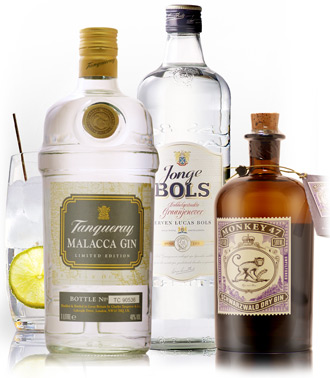
Gin:
From Genever to London Dry.
As Cognac is to France and Whisky is to Scotland, Gin is England's (unofficial) national spirit and for many people an embodiment of 'Englishness'. Yet the English didn't invent Gin. Rather, like many spirits and liqueurs, Gin (or something similar) began as a medicine. Juniper berries, Gin's key flavouring, were long held to have therapeutic qualities, and macerating the berries in alcohol created a heavily flavoured spirit, which later evolved into its contemporary, light bodied, dry tasting counterpart.
Tradition offers one version of the origins of Gin from the 15th Century. Aware that the oil from juniper berries had a strong diuretic effect, a Dutch physician named Dr. Franciscus de la Boe (more widely known as Dr. Sylvius) in the university town of Leiden, concocted from juniper and spices what he thought was an inexpensive medicine. Dr. Sylvius mixed the berries with alcohol to make a purifying tonic - this "medicine" was known as 'genever' in Holland (pronounced je-knee-ver),from the French name for juniper berry, 'genievere'.
Others point out that while Dr. Sylvius may well have been the first to record a formulation for distilling with juniper, he wasn't the first to distill with it, a practice which "...almost certainly goes back to the 11th century when the learned monks of Salerno in Italy were making medicinal potions by distilling a wine spirit together with various roots, berries and herbs... Juniper flavoured distillates made appearances at various times from then onwards." (1)
What did make the Dr.Sylvius's recipe significant, was his choice of grain alcohol for his creation, as opposed to the traditional source of alcohol from the distillation of grapes or fruit. (i.e.-Brandies). It soon found favour across the English Channel; first as a medicine (Samuel Pepys wrote in 1660 of curing a case of "colic" with a dose of "strong water made with juniper") and then as a beverage. British soldiers encountered it as they marauded around northern Europe in the Thirty Years War and found it much to their liking. They brought back a taste for the "Dutch Courage" as they called the 'medicine' (often taking a good slug before battle), and inevitably made their own contribution to the lexicon of spirits: The word 'genever' was corrupted by the English to 'Ginever' and finally abbreviated to 'Gin'.
However, the drink never really picked up in England until the "Glorious Revolution" of 1688, when a union of parliamentarians and the Dutch steward William The Third of Orange overthrew the kingdom of King James, The Second of England. The new King attempted to discourage the importation of brandy from Catholic countries by setting high tariffs on imports. As a replacement he promoted the production of grain spirits ("corn brandy" as it was known at the time), by abolishing taxes and licensing fees for the manufacture of such local products as Gin. (Other sources claim that the reason was simply because Gin was safer to consume than drinking water). Whatever the case, the population loved it and for the first time, England became a nation where spirits were widely consumed by all social demographics. Anyone could now distill by simply posting a notice in public and waiting ten days, so that by the 1720's, 7,000 dram-shops had opened all over England. By 1740 more than 15,000 of the 96,000 houses in the capital sold drink, about 9,000 were Gin-shops. The production of Gin increased to six times that of beer, and because of its affordability, it became especially popular with the poor. Sometimes Gin was distributed to workers as part of their wages. Mass drunkenness became a serious problem. Smollett, the 18th century Scottish novelist wrote:"In these dismal caverns ('strong water shops') they (the poor) lay until they recovered some of their faculties and then they had recourse to this same mischievous potion".Meanwhile, Lord Hervey observed:"Drunkenness of the common people was universal, the whole town of London swarmed with drunken people from morning till night."
The English painter, printmaker, pictorial satirist, social critic and editorial cartoonist, William Hogarth, produced one of the most famous depictions of the period in the engraving "Gin Lane" [pictured below]. It is a companion piece to 'Beer Street' which shows a happy city drinking the 'good' beverage of English beer, versus 'Gin Lane' - an apocalyptic scene of idleness, that begins with vice and misery and ends in madness and death.
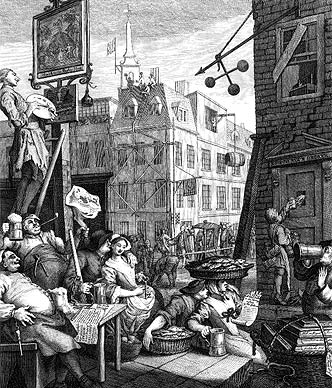 |
 |
| A convivial scene in "Beer Street". William Hogarth (1751) | The reckless abandon of "Gin Lane". William Hogarth (1751) |
A sign above a Gin shop reads,"Drunk for a penny / Dead drunk for twopence / Clean straw for Nothing."While on the stairs in the centre, a mother is too intoxicated to notice her child falling from her arms, echoing the tale of Judith Dufour who strangled her baby so she could sell its clothes to buy Gin. It was probably during this time that another nickname for Gin emerged, "Mother's Ruin", which also referred to the enormous popularity of Gin amongst women. Numerous pamphlets and magazine articles also denounced Gin as the ruin of family life. The demand for reform became unstoppable. Of the attempts by the government to quell Gin production, the Gin Act of 1736 caused the most outrage by fixing a license fee of £50 for Gin retailers, prohibiting the sale of Gin in quantities under 2 gallons and taxing Gin at £1 per gallon. On the night before the Act was to become law there was a night of Gin induced hysteria. Mock funeral processions took place all over the country with people carrying effigies of 'Madam Geneva'. In London, taverns painted their punch bowls and signage black and an official funeral for Mother Gin took place in Swallow Street, just off Piccadilly. The next day dawned on what must have been one of the biggest collective hangovers of all time. The Prime Minister, Sir Robert Walpole and Dr. Samuel Johnson were among those who opposed the Gin Act since they considered it could not be enforced against the will of the common people. They were right. The Act resulted in massive illicit distilling and the cynical marketing of "medicinal" spirits with such fanciful names as 'Cuckold's Comfort', 'Ladies' Delight', 'Knock-me-down', and 'My Lady's Eye Water'. During the six years of the Gin Act, only two distillers took out licenses, yet production rose by almost 50%.
The Act was finally repealed in 1742 and a new policy was introduced with the help of distillers: reasonably high prices, reasonable excise duties and licensed retailers under the supervision of magistrates. (In essence the situation which exists today). "The combination of reimposed government controls, the growth of high-quality commercial Gin distillers, the increasing popularity of imported rum, and a general feeling of public exhaustion gradually brought the situation under control, although the problems caused by the combination of cheap Gin and extreme poverty extended well into the 19th century. Fagin's irritable comment to a child in the film Oliver -"Shut up and drink your Gin!"-had a basis in historical fact".(2)
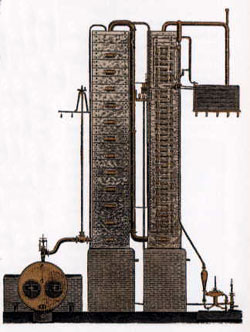 |
| Above: An Early Column Still. |
The Gin being produced in London continued to be similar in style to the original Dutch Genever and the upper classes who drank the imported Dutch article called it by a variety of names that reflected its Dutch heritage - 'Geneva', 'Hollands' or 'Schiedam'. The word 'Gin' was something of an insult, a left over reflection of the mostly inferior spirit that the poor had drunk in the days of the great 'Gin Craze' (indeed a recipe from the 1740's from the firm of Beaufoy James and Co. doesn't even mention juniper). After 1830, the style of all English Gin began to change, when the French born, but Irish raised inventor, Aeneas Coffey, a Dublin Excise Officer, invented the revolutionary Column Still (also known as the Continuous Still, pictured right). More efficient than the Pot still, which had otherwise been used in the production of Gin, the Column Still produced a consistently light bodied and clean spirit to a pre-determined strength. Consequently, Gin distillers no longer had to mask the flavours of inferior spirit with sugar and strong spices. They turned their attention to a new kind of Gin. It was called "Dry Gin" because it was clear and unsweetened and it was flavoured with more subtle aromatic botanicals like coriander, cassia, angelica and orris root. Because most of the distillers making this type of Gin were based in London they bottled their products as "London Dry Gin" and the name stuck. Whilst many distillers continued to make Old Tom style Gin until well into the 20th century, the Column Still set the standard for all contemporary Gins and the London Dry style flourished during the nineteenth century. It became the natural choice of Britain's administrators and officer classes in the colonies abroad. In fact, wherever the Union Jack went, English-style Gins followed. In the tropical British colonies, London Dry's ideal mixing abilities masked the bitter taste of tonic water fortified with quinine, a solution drunk with sugar, soda water and lemon juice to ward off malaria.
In British North American colonies, such celebrated Americans as Paul Revere and George Washington were notably fond of Gin, and the Quakers were well-known for their habit of drinking Gin toddies after funerals. Later, Gin became popular during the Prohibition era of the 1920's, which simultaneously marked the downturn for the Gin industry in England. Tanqueray would continue to ship its Gin to islands just off the U.S. coast, but most people in the United States drank the poor quality, homemade spirits found in speakeasies. This alcohol -then called bathtub Gin - was the most popular spirit being made in the United States because it was the easiest to distill, what'smore, Gin, unlike whisky, did not require any aging in oak barrels which were expensive and cumbersome to store and conceal.
Bathtub Gin was made by placing a large quantity of (often dangerously) low-quality, de-natured alcohol in a home bathtub. The poisons were removed from the liquid to recover ethyl alcohol that was then flavoured with juniper berries, diluted and put into bottles. The highly variable quality of the spirit meant that consuming it in any quantity was a dangerous venture that cost some party-goers their lives. It has also being suggested that the many extravagant cocktails of the Jazz Era owe their inspiration to disguising the disgusting taste of bathtub Gin.
When vodka became highly fashionable in the West during the 1970's, the Gin industry was challenged with a marketing overhaul. For many, Gin still conjured up images of old colonial empires and the Queen Mother. The Gin market was fairly stagnant during the seventies and eighties until Michael Roux (responsible for the launch of Absolut Vodka in the U.S.) recognised an opportunity for a contemporary and stylish new 'super-premium' Gin. By adapting an old recipe from 1761, he created Bombay Sapphire, launching it to the American public in 1988 with great success. Lowering the juniper content and raising the citrus to offer a cleaner, lighter taste, Bombay Sapphire built a bridge for vodka drinkers to cross, lured by trendy advertisements and striking packaging[right].Another such brand is Martin Millers, which is pot-distilled using ten botanicals and then shipped to Iceland to be diluted with pure spring water. The result is a very soft, subtle and distinctive Gin and one which appeals to the 'non-Gin drinker'. Having identified the vodka market as the largest growing spirit sector, Gin brands have continued to tap into the ideas and marketing techniques used by the vodka industry.
Bartenders continue to challenge one another to create recipes for Gin-based cocktails with glamorous names like 'Blue Moon' and 'Pink Lady'. The subtle character of Gin, not to mention its high adaptability to mixing, has contributed to its ongoing popularity in North America. More recently its obvious qualities as a mixable, along with being the prime ingredient in the martini and Gin & tonic have allowed it to keep up to high competition from other white spirits like vodka and white rum. In the past few years, an abundance of new Gin brands have emerged, each with its own peculiar appeal. Since, by law juniper is the only ingredient which must feature in the botanical mix, Gin can contain a whole range of bizarre and unusual flavour possibilities giving distillers a huge scope for creativity. Two recent trends are the development of high strength Gins from traditional producers, designed for the premium 'connoisseur' market (Tanqueray's No.10 &Beefeater's Crown Jewel for example), and the emergence of flavoured Gins (in particular Sloe Gins).

Types of Gin
A Gin's character is determined by three elements: (1) the base spirit; (2) the variety of botanicals - each distiller having his/her own secret recipe; and (3) the type of still and method for distilling.
London Dry Gin
Originally, the term "London" signified Gin produced in or near London, where most English Gin has always been distilled. Today the term which has been adopted by Gin producers the world over, no longer indicates any specific geographical associations. Virtually all Gins on the market also use the word 'dry' on the label. Some may read Dry Gin, Extra Dry Gin, Very Dry Gin, or English Dry Gin, but all mean the same thing - they are equally lacking in sweetness. English Gins differ in character from Dutch Gins primarily because of differences in production (e.g. the use of a continuous still rather than a pot-still). After the cooked mash is fermented, it is distilled in a continuous still with at least three columns. The aim is to purify the spirit to the point that the resulting alcohol is totally neutral and flavourless. The spirit, which leaves the still at a very high proof (approximately 90% alcohol by volume), is then re-distilled with the botanical flavourings. London Dry Gin remains the dominant Gin style in the United Kingdom, former British colonies, the United States, and surprisingly, Spain, where it is nearly always mixed with cola.
Plymouth Gin is relatively full-bodied (when compared to London Dry Gin). It is clear, slightly fruity, and very aromatic. Originally the local Gin style of the English Channel port of Plymouth, modern Plymouth Gin is nowadays made only by one distillery in Plymouth, Coates & Co., which also controls the right to the term Plymouth Gin.
Old Tom Gin is the last remaining example of the original lightly sweetened Gins that were so popular in 18th-century England. The name comes from what may be the first example of a beverage vending machine. In the 1700s some pubs in England would have a wooden plaque shaped like a black cat (an "Old Tom") mounted on the outside wall. Thirsty passersby would deposit a penny in the cat's mouth and place their lips around a small tube between the cat's paws. The bartender inside would then pour a shot of Gin through the tube and into the customer's waiting mouth. Until fairly recently limited quantities of Old Tom-style Gin were still being made by a few British distillers, but they were, at best, curiosity items.
'Genever' is the Dutch style of Gin, known in the Netherlands as Jenever or Shiedman, amongst other titles.
Its aroma and flavour is fuller and riper than that of the London Dry style. Although the same botanicals used in making Genever Gin are also used in making other styles of Gin (albeit in different proportions), it is the nature of the base spirit which gives Genever Gin its distinctive taste and character, which like Scotch whisky or Bourbon, is usually made from a fermented wash of malted barley with equal parts corn and rye. Unlike London Dry styles that use base spirits of 90% alcohol or more, the malt wine in Genever Gin comes out of the pot still at about 50% alcohol. The resulting liquid is, therefore, not completely purified of the flavourful congeners in the mash, which accounts for its malty, full-bodied taste and aroma. In producing Genever Gin, part of the malt wine is re-distilled with botanicals, including caraway (a herb distinctive to Dutch Gin). The spirit is then blended with a varying amount of malt wine from the first distillation. This process of blending yields the two types of Genever Gin - 'Oude Jenever' (Old Genever) is the oriGinal style. It is straw-hued, relatively sweet and aromatic. The second type, 'Jonge Jenever' (Young Genever), usually clear in colour, contains a smaller proportion of malt wine to produce a beverage with a drier palate and lighter body. Genever is traditionally sold in a cylindrical stoneware crock. Genever-style Gins are produced in Holland, Belgium, and Germany. Some Genevers are aged for one to three years in oak casks and tend to be lower proof than English Gins (72-80 proof or 36-40% ABV is typical). They are usually served straight up and chilled. The classic accompaniment to a shot of Genever is a dried green herring.
Other Gin Styles include:
* Wacholder: the German equivalent of Gin. Steinhager, arguably the best version of this type of Gin, originates from the village of Steinhagen in Westphalia. This beverage has a strong juniper flavour because it is distilled from fermented juniper berries. It is often bottled in stoneware crock bottles.
* Flavoured Lemon or Orange Gin Collins: These Gins are produced in the same manner as other dry Gins except that dried lemon or orange peel is added as the primary flavouring agent. Juniper and other botanicals are also used but do not dominate the taste. These citrus-flavoured Gins are ideal with soda or fruit juices as a long drink.
* Pimms: Pimms No. 1 Gin Sling, a famous Gin-based cocktail, is named after James Pimm, a 19th Century restaurant owner. He invented the Gin sling for his customers but it proved so popular, he began commercial manufacture. The original Pimms No. 1 Cup is basically Gin compounded with herbs and essences, and enhanced with a European liquor.
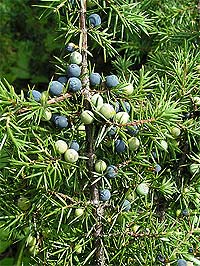
How Gin is Made
Essentially, Gin is nothing more than a neutral spirit (more commonly known as vodka) with added botanical-flavours. The spirit base for Gin, like vodka, can be made from a variety of washes, including corn, barley, rye, molasses and other small grains. As has been mentioned, most Gin made today is initially distilled in efficient column stills. The resulting spirit is high-proof, light-bodied, and clean with a minimal amount of congeners (flavour compounds) and flavouring agents. Genever Gin, on the other hand, is distilled in less-efficient pot stills, which results in a lower-proof, but more flavorful spirit.
The main botanical used in flavouring Gin is of course, the juniper berry, a blue-ish green berrylike fruit that grows on a low-slung evergreen bush(genus Juniperus),commercially grown in northern Italy, Croatia, the United States and Canada. A small number of genevers in Holland and Belgium are distilled directly from fermented juniper berries, producing a particularly intensely flavoured spirit. Over the centuries, creativity and diversity have seen Gin recipes ranging from a handful to a mix of a dozen or more individual ingredients, the most common being almond, angelica root, cardamom, cassia bark, coriander, cubeb berries, grains of paradise, Ginger, lemon peel, liquorice, nutmeg, orange peel and orris root. More adventurous concoctions include such diverse ingredients as Cucumber and Rose petals, as is the case with Hendrick' s Gin.
There are three main ways to add flavour to the base spirit. The traditional way is to mix the botanicals with the spirit; this mixture is then re-distilled. But some Gin makers prefer to hang the botanicals above the spirit where the rising alcohol vapours absorb the flavours while passing through to the condenser. This first method is called percolation; the second method is known as infusion. Traditionally, trays were placed above the kettle (just at the base of the helmet) so that as the vapors rose from the heated ethanol they would extract flavouring oils and aromatics compounds from the herbs and berries. The ingredients suspended in the tray could be dried or fresh. Naturally, dried herbs impart less character than fresh ones and a larger quantity is needed to achieve a certain degree of flavor. On the other hand, while fresh berries and herbs will yield a stronger bouquet and less is needed, the cost of the raw material is higher.
A third, more efficient way of adding botanicals is the cold-mix system, which uses the process of maceration. Maceration involves soaking the flavouring elements in a small amount of neutral spirit. This spirit is then distilled to yield a powerful concentrated essence. The essence is then mixed with other neutral spirits to achieve the desired flavour. Some distillers export only the essences, which are blended into Gin in the country where they will be sold.
Needless to say, if everyone used the same ingredients there would be no distinction, no competition and no choice! Ultimately, the beauty of contemporary Gins lie in the artistic prowess of the distiller.
Serving Gin
The way you serve your Gin naturally depends upon the style of Gin you prefer. The Dutch like their Genever Gins straight and cold. The heavily flavoured, full-bodied nature of these Gins makes them not especially adaptable to mixing. The London Dry style, on the other hand, lends itself to decadently elegant cocktails. The juniper character demands an almost equally forceful 'bite'. Traditionally this was found in Angostura bitters, along with tonic or club soda water and citrus fruits such as lime, lemon and orange. Whether a fizz, sling, collins or Gin and tonic, a common denominator for mixed Gin drinks is that they are refreshers, served in the tallest bar glassware there is (known as a collins glass).
Of course, it is the Martini, arguably the most famous cocktail in the world, which has guaranteed Gins place in bars around the world (see below). All Martini recipes call for ice-cold Gin along with some dry vermouth (the drier the vermouth, the drier the Martini), garnished with a green olive or a lemon twist. A pearl onion transforms the drink into a "Gibson". Over the years the mixture has become progressively drier, requiring a larger percentage of Gin than vermouth in the blend. Before World War I, proportions were three measures of Gin to one measure of vermouth, but today some people merely spray the glass with vermouth. The great British statesman Winston Churchill, who devoted a great deal of thought and time to drinking, was of the opinion that passing the cork from the vermouth bottle over the glass of Gin was sufficient.
Gin Today - The Second Glorious Revolution.
That line of thinking misrepresents all this spirit can be in the hands of visionaries and fanatics. The freshest botanicals in high quality alcohol can result in an exotic amalgam of accents and supporting notes that no white spirit can match. Perfumed complexity and bracing intensity are not the characteristics of every Gin we taste - hence, it can't be that easy to achieve. The reality is the greatest examples in this genre are not commonplace. The most average are.
Trending classifications such as 'New Western' style (juniper evident but not dominant) are gaining prominence with modern day producers, encompassing the use of indigenous botanicals and varied spirit bases, including non-grain. Barrel ageing is also gaining momentum. The vast improvement in quality has resulted in texture rich, neat/sipping friendly spirits. Yet, the traditional English and Dutch styles remain more relevant than ever in honouring the cocktail classics. Tonic, has also reincarnated into drier expressions of yester-year such as Fever Tree (our present favourite), while a customer recently reported encountering 3-4 pages of garnish-rich Gin and Tonic variations during his stay in Barcelona.
Surprisingly, one of Australia's first forays into specialised Gin production was by James Underwood in 1823, who established his Sydney Distillery in Paddington when distilling was legalised in New South Wales.
Gin might have been an obvious choice given its strong connections with England.
However, its recent favour and success has had little to do with tradition, but rather its creative renditions - often incorporating a multitude of native botanicals - and not just in Australia. Gin is losing 'definition' on the global scale. Australia's Gin future shows great promise with dedicated Gin distilleries emerging and over time, we anticipate the changes will be more radical, and even lead to a Gin designation of our own. The quality is certainly there!
Classic Gin Cocktails
The Gin Martini
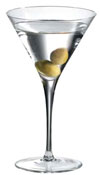
A true Martini is always made with Gin, and always includes Vermouth.
No other cocktail has attained quite the status or mystique as this classic combination. The history of the Martini is long and involved, to the point of being totally confusing. For example, the drink was supposedly 'born' several times in different places within 2-3 decades during the late 19th century. Jerry Thomas, bartender at San Francisco's Occidental Hotel, mixed up a "Martinez" for a traveler bound for that town. It consisted of bitters, maraschino, vermouth, ice and Old Tom (Sweet Gin). Sugar syrup added on request. Another story tells of a gold miner who paid for a bottle of whiskey in the town of Martinez with a nugget so big he demanded an extra drink. The bartender dubbed it a "Martinez". Whatever the truth of its origins, sipping a well-crafted Martini chases all the confusion away. There is a certain culture, or mind set that accompanies individual contemplation of a classic Martini. However, what passes as a Martini in many cocktail lounges across the country today, is often best described as "Gin Up", or in other words a couple ounces of gin, shaken with ice, and then strained into a cocktail glass.
A Martini is a cocktail, and a cocktail contains more than just a single ingredient. Some will argue a cocktail should contain at least three ingredients, in which case a dash of Orange Bitters to a traditional Martini is often accepted. A well-balanced cocktail should be able to cloak its ingredients in a slight mystery. Changing the garnish of a Martini from the common green olives to a couple cocktail onions cause it to be renamed to a "Gibson", if such a simple change provides a new name, then shouldn't the changing of a major ingredient also be a different drink? It was a marketing ploy by the Smirnoff Company that implied that a Martini could just as easily be made with Vodka instead of gin. But this is a totally different drink, and as such has its own name, which is the "Kangaroo cocktail". If you're the type of person that enjoys a good Martini, then spend a little time learning to understand it better. If you play around with several different brands of gin, different ratios of dry and/or sweet vermouth, and a few dashes of Orange Bitters, you just might learn a new appreciation for some of the interesting complexities that can accompany this legendary cocktail.
Method: Stir with ice. Strain into a cocktail glass. Garnish with either a lemon zest or a green olive. The Gin to Vermouth ratio listed here is 5 to 1. An "extra-dry" martini can take this to such an extreme as to have no vermouth at all. - notes partially sourced from www.drinkboy.com |
The Gin Sling
This cocktail was first described in print as a bittered sling. Before the addition of bitters, a sling was spirits, sugar water and sometimes lemon.
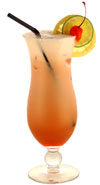
- 30ml London Dry Gin
- 20ml Cinzano Rosso Vermouth
- 15ml Lemon Juice
- 20ml Sugar Syrup
- 1 dash Angostura aromatic bitters
- Soda Water, Lemon Peel Spiral
- Method: Method: Shake all the ingredients except the soda water with ice and strain over ice into a collins or tulip glass. Top with soda. Garnish with a spiral of lemon.
The Alexander
This is the original Alexander and is figured to be the father to the White Russian. It is sometimes garnished with grated nutmeg or cinnamon.
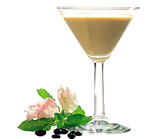
- 30ml Bombay Sapphire London Dry Gin
- 15ml White Creme de Cacao
- 30-50ml light cream
Method: Shake with ice in a cocktail shaker. Strain into a cocktail glass. Decorate with a cherry if you are feeling a bit swanky...
1. Dutch Courage, by Geraldine Coates www.Gintime.com
2. Some notes partially taken from Alan Dikty, Contributing Editor for Tastings.com. An engineer by profession and spirits expert by nature, Mr.Dikty has built and consulted for microbreweries and brewpubs from Azerbaijan to Saipan.
